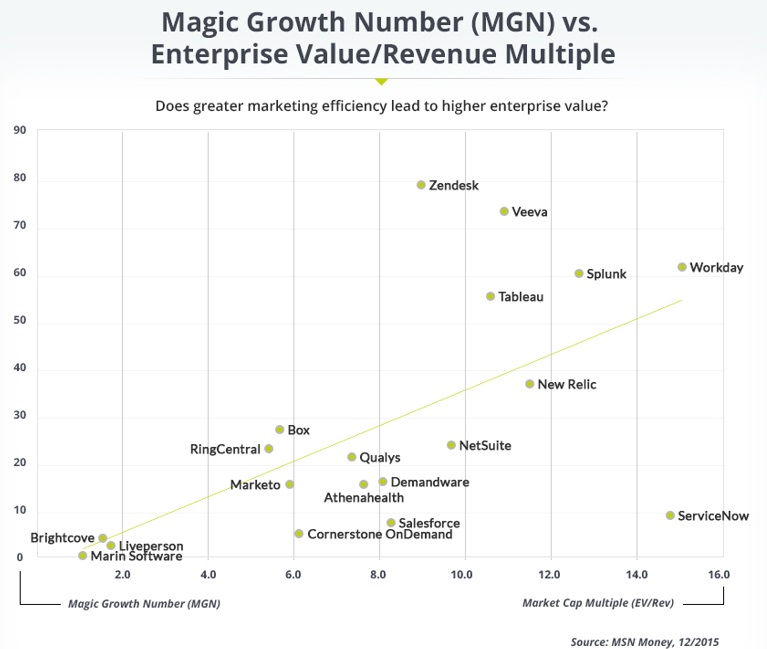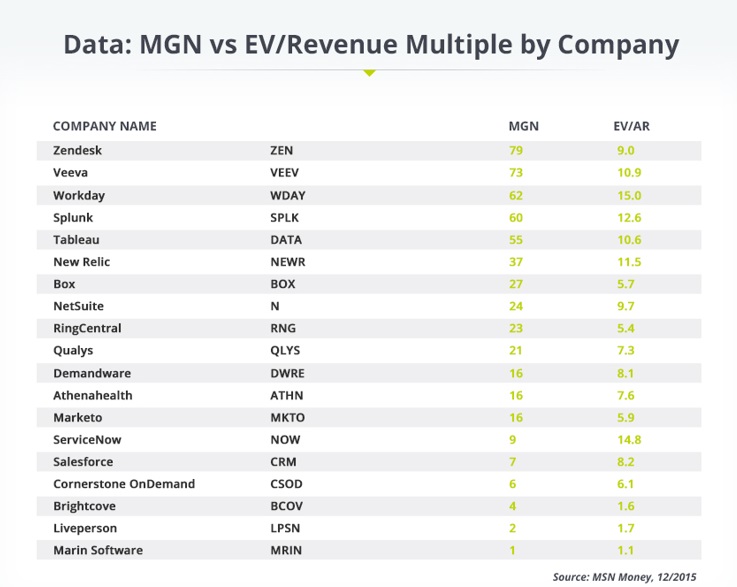It’s great to grow revenue fast (e.g., 50% or more), but not if that growth comes at too steep of a cost. The most valued tech software and services companies are those growing the fastest AND acquiring new customers with the most efficient go-to-market model.
To gauge the efficiency of a company’s go-to-market model, CMOs are increasingly using a metric called the ‘Magic Number.’ The Magic Number is the product of a simple equation: Start with the difference in new customer revenues between the most recent two quarters. Divide that number by the earlier quarter’s sales and marketing total expenditures (people and program dollars) for acquiring new customers. Multiply by four to annualize, and … voila. No, it’s not magic — but the idea is that the metric gives executives (and investors) a measure of how efficient your marketing efforts are.
Common thinking is that a Magic Number greater than 1, is a compelling business investment, a result below .5 is a company that has not figured out an efficient go-to-market model, and a result in between is a company that needs improvement before scaling (or becoming a public company). A company with a Magic Number above 1.5 is amazing — pour more fuel on the fire!
This formula is useful but shouldn’t be confused with other and more operational barometers of business success. Full funnel metrics are critical so you understand exactly where you are more/less efficient at each step in the customer-acquisition funnel. These metrics help you understand which marketing programs, channels, and offers (content) are most effective with your different buyer personas and at each stage of the buying process.
AI Weekly
The must-read newsletter for AI and Big Data industry written by Khari Johnson, Kyle Wiggers, and Seth Colaner.
Included with VentureBeat Insider and VentureBeat VIP memberships.
I’ve thought a lot about how to come up with a more accurate measure of growth efficiency – one that combines the two most critical dimensions for maximizing a company’s shareholder value — Revenue Growth + Magic Number. Here’s what I’ve come up with: the Magic Growth Number (MGN). MGN takes the Magic Number and multiplies it by the annualized growth rate of the company. For example, a company growing at a 33 percent rate would multiply its Magic Number by 33 to come up with its Magic Growth Number. MGN is the most comprehensive single metric for describing a company’s overall go-to-market effectiveness.
As discussed earlier, a Magic Number between 0.5 and 1 is considered ok; anything above 1 is strong. The Magic Growth Number offers more variability transparency by looking into the effectiveness of that growth. An average MGN will be about 20 to 30, but it can vary from 0 to over 100. The higher the MGN, the better.
Why the Magic Growth Number matters
The chart below plots the current MGN for 19 of the largest publicly traded SaaS companies against their Enterprise Value multiple (Enterprise Value divided by annual revenue). You can find the full data at the end of this post.

Analyzing the graph, there is a strong and direct correlation between a company’s MGN and its EV multiple (valuation) with only one real exception (ServiceNow). In other words, the more efficient a company’s marketing and sales are, the more value that company creates for its shareholders.
Why is this? The reality is that marketing has become THE most efficient way to accelerate growth in our digital economy. And because growth marketing is scalable (where sales is a one-to-one function), marketing budgets are able to grow quickly as their ability to scale company value is proven.
Think about it, if a company’s Enterprise Value is 5x its annual revenue, then every new dollar of revenue is worth at least 5x the expense dollar given to marketing and sales to produce that incremental revenue (measured by the Magic Number metric). The imperative is to connect the dots so each marketing expense dollar is aligned and reported against revenue growth.
Consider Veeva in the graph above, which has the luxury of targeting a very specific vertical market, life-sciences. Its marketing team is able to be efficient with its growth marketing program dollars, leading to its favorable placement in the graph. Box, on the other hand, is targeting a competitive horizontal market while trying to move up-market, which taxes growth efficiency. Most other companies fall somewhere in between these two and need to sweat the details across their go-to-market model.
Here are three strategies to help you improve the Magic Growth Number of your company (and create more shareholder value):
- Sweat your funnel economics: Work back from your future quarters’ revenue targets, based on historical conversion rates as you climb up your new customer acquisition funnel. For example, if you are looking to acquire 50 new customers next quarter and your company has a historical 50 percent opp-to-customer conversion rate, then you need 100 new opps this quarter. Continue working backward until you reach the top of the funnel — and set those numbers as goals for your marketing teams (those responsible for each phase of the new customer’s journey).
- Ensure efficient hand-offs: Sales and marketing share your funnel. Within those groups there are even more subgroups — lead generation, email marketing, sales development, account executives, etc. Leads get handed off multiple times between these groups and you need to make sure it’s being done efficiently and that everyone understands and agrees on a process that results in maximizing efficiency. The key is to hand a new customer from one stage/team to another with maximum speed and clarity, ensuring a speedy trip through the funnel.
- Benchmark and prepare for the future: Every month, every quarter, every year. Make sure you are benchmarking your efficiency compared to your past performance and compared to other similar companies. It’s best to invest in new growth initiatives (new product lines, geographies, verticals, segments) as early as possible; once you’re public, access to growth capital is harder to get, and public investors want higher margins and more a more efficient go-to-market model.
The future of growth and value creation among tech companies is largely in the hands of marketing.
There’s never been a better time to be a CMO — more budget and growth responsibility, and (finally) growth marketing is as measurable as sales. Architecting and making your customer acquisition process efficient is hard work, but the results are amazing. Marketing moves the needle on shareholder value in a big way. Tomorrow’s winners are leveraging the latest marketing technologies, sweating their funnel processes/metrics, while hiring the best people. Make it happen, and enjoy the journey.

Paul Albright is CEO and cofounder of Captora. He was previously Chief Revenue Officer at Marketo, where he led the overall growth strategy across sales and marketing, delivering global revenue growth over 100% year-over-year, from $14m to $58m. He held a similar position at SuccessFactors, where he grew revenues to more than $200m and over 80% year-over-year growth. He also previously worked at Greylock Partners as a CEO-in-Residence. He currently serves on the board of directors of Aasonn, Captora, and Clarizen and is a frequent speaker and blogger.
VentureBeat's mission is to be a digital town square for technical decision-makers to gain knowledge about transformative enterprise technology and transact. Learn More
